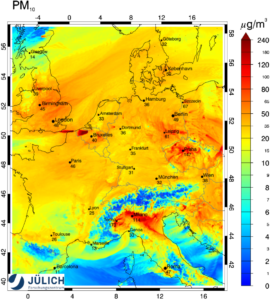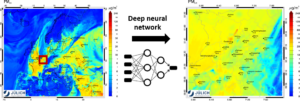Air Quality Forecasting Analysis System
Exploring ECMWF’s digital twins’ applications for air quality analysis and forecasts.
In a nutshell
- High-resolution air quality forecasts and analyses are key for national and regional environmental agencies to understand the underlying phenomena, the cause of air pollution, and potentials to initiate appropriate measures to limit air pollution during extreme events.
- The DestinE air quality use case develops an interactive
air quality forecasting and analysis system to assess the population exposure.
- The use case combines the advantages of machine learning applications and numerical modeling with EURAD-IM.
Technical Overview
Challenge
Weather events like heat waves or droughts are frequently accompanied by severe air pollution. For example, high temperatures and strong solar irradiation during heat waves favor the production of ground-level ozone (O3) and can thus lead to extreme O3 concentrations posing a threat to humans and the environment. In addition, stable wintertime anticyclones cause extreme particulate matter (PM) concentrations due to enhanced residential heating and reduced dynamic mixing of the air mass. Hence, high-resolution air quality forecasts and analyses are key for national and regional environmental agencies to understand the underlying phenomena, the cause of air pollution, and potentials to initiate appropriate measures to limit air pollution during such extreme events.

DestinE Solution
In this context, the DestinE air quality use case develops an interactive air quality forecasting analysis system to assess the population exposure. The system is based on a web-based user interface that will trigger high-resolution air quality analyses and forecasts produced by machine learning methods as well as the chemistry transport model EURAD-IM (European Air pollution Dispersion – Inverse Model). The machine learning approaches allow fast and precise air quality forecasts at the location of air pollution monitoring stations by fusing weather forecasts and ground-level observations. At the same time, EURAD-IM provides detailed forecasts and analyses of air quality in Europe on the spatial scale governed by the digital twin. The system further allows for detailed emission modulation illustrating the effect of mitigation scenarios on air pollution.

The use case combines the advantages of machine learning applications and numerical modeling with EURAD-IM. The machine learning modules are based on neural network approaches exploiting longtime datasets and allow for air quality predictions at the location of European observation stations and downscaling of coarse resolution numerical predictions to high resolution ground-level fields. The EURAD-IM is a chemistry transport model that can be executed to include three-dimensional variational data assimilation to combine the best available information on the atmospheric state. As base for air quality simulations serve, among others, meteorological data from the DestinE Extremes Digital Twin, in situ observations, and high-resolution anthropogenic emission data and temporal emission profiles. The ensemble generation will feature a modular emission control panel in the user interface that allows detailed modifications of the emission data on an emission sector basis (e.g. industry, road transport, agriculture etc.). All use case components will be run flexible and interchangeable, whereas machine learning tools are run on the service front end, while the EURAD-IM will directly couple to the model data of the DestinE Digital Twin.

Impact
To demonstrate the information gained, two demonstrator simulations are planned to be delivered to the DE_370C core users LANUV (North Rhine-Westphalia Office of Nature, Environment and Consumer Protection) and UBA (German Environment Agency). Here, the focus is placed on high-resolution simulations in the areas of North Rhine-Westphalia and Berlin-Brandenburg. The first demonstrator prediction covers an O3 episode in July/August 2018, while the second demonstrator simulation analyses a PM episode in Winter 2016/2017. Both demonstrators will be designed in close exchange with the core users to incorporate the required output formats, ease of simulation control (i.e. triggering and output handling) and emission scenario design. These scenarios will be available to be selected via the user interface. Besides, a flexible tool to modulate the emissions on a sector and/or regional basis will be included in the demonstrator as a prototype. This may also include the modulation of temporal emission profiles to show the potential of, e.g., the implementation of stay-at-home orders during air pollution episodes.
